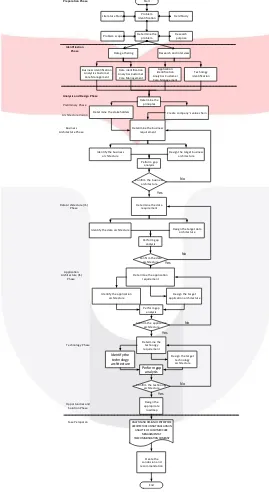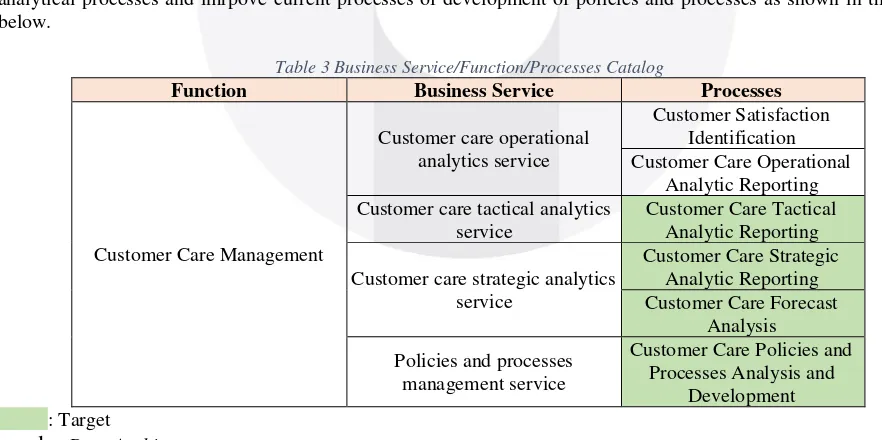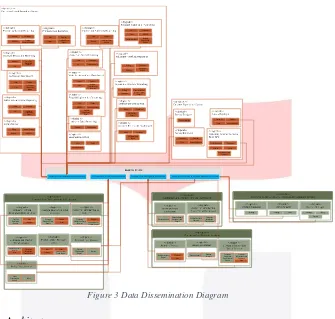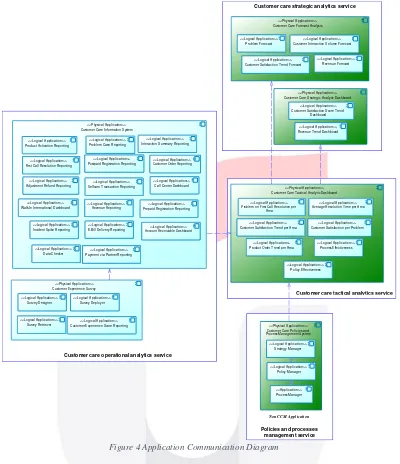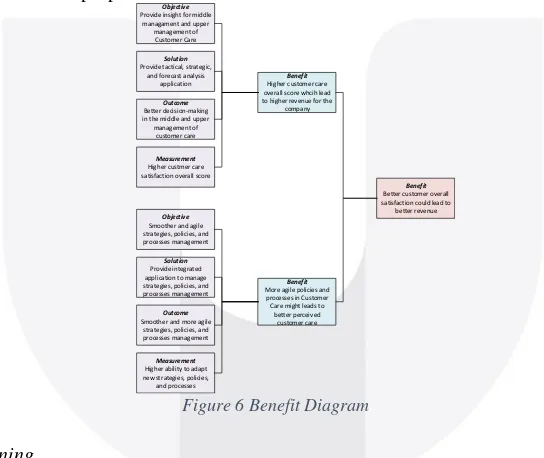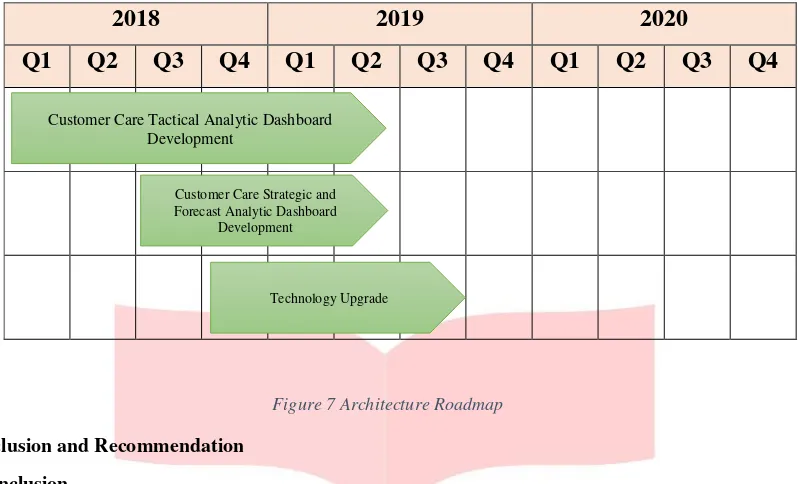ANAYSIS AND DESIGN OF ENTERPRISE ARCHITECTURE USING TOGAF ADM IN ANALYTIC OF CUSOTMER CARE MANAGEMENT AT
TELECOMMUNICATION COMPANY
1Lanusgana Amerta, 2Yuli Adam Prasetyo, S.T., M.T., 3Dr. Basuki Rahmad, CISA.,
CISM., CRISC
123Information System Program, Industrial and System Engineering Faculty, Telkom
University
1[email protected], 2[email protected], 3[email protected]
Abstract
PT XYZ is one of the biggest cellular telecommunication provider in Indonesia. One of its main concern is Customer Care Management. This research focuses on the Analytic of Customer Care Management, which positioned under Sales Directorate. Analytic of Customer Care Management has the main purpose to do analytical services and strategies, policies, and processes management for Customer Care Management. In this research, TOGAF is being used to develop Analytic of Customer Care Management’s enterprise architecture. This research is limited only from preliminary phase to migration planning phase. In each of these phase, existing architects are being identified and also target architectures are being proposed. Hopefully, this research could help provide insight to the telecommunication company regarding baseline of Analytic of Customer Care Management.
Keywords: Enterprise Architecture, TOGAF ADM, Customer Care Management, Telecommunication Company
1.Introduction
PT XYZ is one of the biggest cellular telecommunication provider in Indonesia. There are a lot of products to offer to customer, these products are categorized to two big categories. The first category is core product or legacy, which consists of voice, text, and data bunding services. The second category is the content product, which mainly consists of third-parties’ products that bundled with company services.
Customer Care activity is one of the most important thing a telecommunication company must managed properly to maintain customer satisfaction, hence gaining growth for the company as the whole. Therefore, it has been establishing Customer Care Management to take care of this activity. Positioned under the Sales Directorate, Customer Care Management or CCM has main task to manages customer interaction (information, request, and complain) via various touch point (walk-in, call-in, e-care, and self-care). Moreover, it is important for the company to manages the Customer Care properly, therefore company could establish good relation with the customers (Bianchi, Schiavotto, & Svobod, 2014).
Customer Care Management currently being divided into two big section. The first section is the operational section, this section is responsible to the operation of managing customer interaction through multiple touch point on the daily basis. The next section is the analytic section, which responsible to provide analytic, such as planning, system development and maintenance, and facility for the operational section.
To provide analytic for the operational section, analytic section has been developing and maintaining some crucial systems for the Customer Care Management. These systems are combination of in-house developed system and cost-off-the-shelf system provided by vendors. However, more systems might be needed to adapt to the ever-changing business environment, and so could maintain high level of growth for the company.
There are two problems that could be identified in this research, the problems are as follow:
• Tactical, strategic, and forecast analytic dashboard are needed to support the business service, hence better decision-making and overall improved performance could be achieved.
• More agile policies and processes improvement are needed to accommodate dynamic business situation.
2. Research Systematic
This section has the purpose to shows the concept o the research that being done based on TOGAF Architecture Development Method. In this research, the research systematic is as follows:
Preparation Phase Start
Problem Identification
Determine the problem
Data gathering
Literature Study Field Study
Problem scope Research
purpose
Research and interview
Business identification Analytics Customer Care Management
Data identification Analytics Customer Care Management
Application identification Analytics Customer Care Management
Technlogy identification
Identifiaction Phase
Determine the principles
Determine the stakeholders Create companys value chain
Deterimine the business requirement
Identify the business architecture
Design the target business architecture
Perform gap analysis
Confirm the business architecture
Determine the data requirement
Identify the data architecture Design the target data
architecture
Perform gap analysis
Confirm the data architecture
Deterimne the application requirement
Identify the application architecture
Design the target application architecture
Perform gap analysis
Confirm the application architecture
Determine the technoogy requirement
Identify the technology architecture
Design the target technology architecture
Perform gap analysis
Confirm the technoogy architecture
Design the appropirate roadmap
ANAYSIS AND DESIGN OF ENTERPRISE ARCHITECTURE USING TOGAF ADM IN ANALYTIC OF CUSOTMER CARE
MANAGEMENT AT TELECOMMUNICATION COMPANY
Create the conclusion and recommendation
Analysis and Design Phase
Fase Pelaporan Preliminary Phase
Architecture Vision
Business Architecture Phase
Data Architecture (IS) Phase
Application Architecture (IS)
Phase
Technology Phase
Opportunities and Solution Phase
Figure 1 Research Systematic
3. Literature Study
The Open Group Architecture Framework or TOGAF is a framework that can be used to developed an enterprise architecture for a company or an organization (The Open Group, 2011) (Dwi, Prasetyo, & Hanafi, 2016) (Christini & Rahmad, 2015). TOGAF plays an important role in the development of enterprise architecture as a standardization and also as an effort to reduce risk during the development of the enterprise architecture.
Phase A: Architecture Vision
This phase explains about the vision of the architecture, including the scope, definition of related stakeholders, and also an approval to start the development of the enterprise architecture
Phase B: Business Architecture
This phase explains about the strategy, products or services, organization, function, processes, and other information related to business of the organization
Phase C: Information Systems Architectures
This phase explains about the information system architecture. There are two big division in this section:
• Data Architecture, which explains about the data involved in the information system architecture • Application Architecture, which explains about the application involved in the architecture
Phase D: Technology Architecture
This phase explains about the technology architecture that being used and/or will be used in the enterprise architecture
Phase E: Opportunities and Solutions
This phase identifies the architecture deliverables, such as project, program, and/or portfolio that effectively realize the target architecture from the previous phase
Phase F: Migration Planning
This phase aim to deliver the plan of migration from the previous architecture (baseline) to the target architecture
Phase G: Implementation Governance
This phase explains about the monitoring of the plan of implementation, to ensure the implementation is going as it should be
Phase H: Architecture Change Management
This phase organizes the procedure to manage the change of enterprise architecture, hence ensuring continuity of the life cycle of the enterprise architecture
ADM Architecture Requirements Management
This section explains about the process to manage the requirement of all phases in the TOGAF ADM
3.2. Customer Relationship Management (CRM)
Customer Relationship Management or CRM is a term that being used to describe the strategy and technology used by a company or an organization to manage and analyze its interaction between the company or organization and the customers. In CRM, business will be helped to arrange and log customer information centrally, therefore further customer identification, including customer satisfaction measurement could be well executed (Jaelani, 2016).
3.3. Performance Dashboard
According to Wayne W. Eckerson, performance dashboard is essentially a performance management system. It has the purpose to translate organization’s strategy into objectives, metrics, initiatives, and tasks for each group and/or individual within the organization. It works by providing information and insights to enable business users to improve the decision-making processes (Eckerson, 2010).
4. Discussion
a.
Preliminary PhaseThis is the first phase of the TOGAF ADM. During this phase, a set of principles is developed. Table 1 Principle Catalog
Category Principle
Business Principles
Adaptive CCM
Maximizing Benefit for Company Business Continuity Beyond Customer Expectation
Common Use Applications
Information Management is Everyone’s
Business
b.
Architecture VisionThis phase also the initial phase in the TOGAF ADM. This phase has the objective to define the vision of the architecture. Furthermore, this phase includes, defining the scope and identifying stakeholders. One of the artifact that being explained in this phase is Architecture Vision, as in this phase, the Architecture Vision is as follow:
Finance
Planning and Transformation
Human Capital Management
Network Marketing Sales Charging Billing Payment
Customer Care Management Information Technology
V
a
lu
e
/
P
ro
fi
t
Support Activities
Core Activites
Customer Care Management Operational
CCM Planning CCM System Management CCM Assurance
CCM Operational
CCM Analytic
Figure 2 Value Chain Diagram
: Focused in the research
c.
Business ArchitectureThis section provides the architecture of business of analytic of Customer Care Management. One of the artifact used in this section is Business Requirement that has the purpose to identifies the requirement of business needed by the analytic of Customer Care Management. Furthermore, this requirement then will be used as guidance of developing necessary business architecture, if needed.
Table 2 Business Architecture Requirement
No Requirement
1 Provide agile policies and processes improvement
2 Every policy and process must be aligned with the strategic plan
3 Provide analytic and decision support for each level of stakeholder (operational, tactical, and strategic) 4 Ensure business continuity throughout customer care management
Moreover, this business architecture also explains the proposed improvement of business processes by adding new analytical processes and imrpove current processes of development of policies and processes as shown in the table below.
Table 3 Business Service/Function/Processes Catalog
Function Business Service Processes
Customer Care Management
Customer care operational analytics service
Customer Satisfaction Identification Customer Care Operational
Analytic Reporting Customer care tactical analytics
service
Customer Care Tactical Analytic Reporting Customer care strategic analytics
service
Customer Care Strategic Analytic Reporting Customer Care Forecast
Analysis Policies and processes
management service
Customer Care Policies and Processes Analysis and
Development : Target
d.
Data ArchitectureData architecture phase has the purpose to define all related matter regarding data architecture. This is the third phase of TOGAF Architecture Development Method. This phase is part of information system architecture phase.
Data Principles
Data is Shared Data is Assets Data Security
Application Principles Ease-of-Use
Technology Independence
Technology Principles Interoperability
Generally, this phase has the purpose to explains about the relationship of data, applications with corresponding data entities, and mapped the data for application development. One of the artifact that being used in this phase is data dissemination diagram, this artifact has the purpose to provide information regarding the relationship between application and its corresponding data entities.
Product Customer MSISDN
Problem Problem Case
Report Unit Product
Unit Problem Problem Case
Report Product Problem
Unit First Call Resolution Report
Unit Customer Order
Order Customer Unit Order Summary
Billing Customer Problem Adjustment Refund
Call Center Interaction Billing Financial Account Customer
E-Bil Delivery Report Billing Financial Account
Customer MSISDN Machine
Survey Question Customer Problem Order Survey Question Customer Problem
Order Survey Response Survey Response
Problem First Call Resolution Report
Area Average Problem Resolution Time
Report Area
Satisfaction Score Summary Product Product Order
Trend Report Order
Customer Satisfaction Score
Summary Satisfaction Per Problem Report
Problem Revenue Report Satisfaction Score Summary
Problem Problem Forecast
Report Area Revenue Report
Area Customer Satisfaction Trend Forecast Report
Customer Satisfaction Score
Summary Revenue Forecast
Strategy Strategy Strategy Process
Policy Policy Customer Care Operational Analytics Service Customer Care Tactical Analytics Service Customer Care Strategic Analytics Service Customer Care Policies and Process Management Service
Product Activation Report
MSISDN Finansial Account Postpaid Registration AR Outstanding
Report Payment Partner
Report
Customer Problem Order Satisfaction Score
Summary
Revenue Report Revenue Trend Report
Figure 3 Data Dissemination Diagram
e.
Application ArchitectureApplication architecture identifies the applications that being used to processes data within the Analytics Customer Care Management. Application could help provide useful information that supports business activities, hence improve business performance.
In this architecture, existing application would be analyzed and mapped. Then, new or improved applications would be proposed. Furthermore, these proposed applications aim to fulfil business requirement while also considering the data architecture needed to develop this architecture.
Non CCM Application
Non CCM Application Customer care operational analytics service
Customer care strategic analytics service
Customer care tactical analytics service <<Physical Application>>
Customer Care Information System
<<Logical Application>> Product Activation Reporting
<<Logical Application>> Problem Case Reporting
<<Logical Application>> First Call Resolution Reporting
<<Logical Application>> Postpaid Registration Reporting
<<Logical Application>> Customer Order Reporting
<<Logical Application>> Adjustment Refund Reporting
<<Logical Application>> Selfcare Transaction Reporting
<<Logical Application>> Call Center Dashboard
<<Logical Application>> Revenue Reporting <<Logical Application>>
Walk-In International Dashboard
<<Logical Application>> Incident Spike Reporting
<<Logical Application>> Prepaid Registration Reporting
<<Logical Application>> Account Receivable Dashboard <<Logical Application>>
E-Bill Delivery Reporting
<<Logical Application>> Payment via Partner Reporting <<Logical Application>>
Data Checker
<<Logical Application>> Interaction Summary Reporting <<Logical Application>>
Product Activation Reporting
<<Logical Application>> Problem Case Reporting
<<Logical Application>> First Call Resolution Reporting
<<Logical Application>> Postpaid Registration Reporting
<<Logical Application>> Customer Order Reporting
<<Logical Application>> Adjustment Refund Reporting
<<Logical Application>> Selfcare Transaction Reporting
<<Logical Application>> Call Center Dashboard
<<Logical Application>> Revenue Reporting <<Logical Application>>
Walk-In International Dashboard
<<Logical Application>> Incident Spike Reporting
<<Logical Application>> Prepaid Registration Reporting
<<Logical Application>> Account Receivable Dashboard <<Logical Application>>
E-Bill Delivery Reporting
<<Logical Application>> Payment via Partner Reporting <<Logical Application>>
Data Checker
<<Logical Application>> Interaction Summary Reporting
<<Physical Application>> Customer Experience Survey
<<Logical Application>> Customer Experience Score Reporting <<Logical Application>> Customer Experience Score Reporting
<<Physical Application>> Customer Care Tactical Analytic Dashboard
<<Logical Application>> Problem on First Call Resolution per
Area
<<Logical Application>> Customer Satisfaction Trend per Area
<<Logical Application>> Customer Satisfaction per Problem
<<Logical Application>> Product Order Trend per Area
<<Logical Application>> Average Resolution Time per Area
<<Logical Application>> Process Effectiveness
<<Logical Application>> Policy Effectiveness <<Logical Application>> Problem on First Call Resolution per
Area
<<Logical Application>> Customer Satisfaction Trend per Area
<<Logical Application>> Customer Satisfaction per Problem
<<Logical Application>> Product Order Trend per Area
<<Logical Application>> Average Resolution Time per Area
<<Logical Application>> Process Effectiveness
<<Logical Application>> Policy Effectiveness
<<Physical Application>> Customer Care Strategic Analytic Dashboard
<<Logical Application>> Revenue Trend Dashboard
<<Logical Application>> Customer Satisfaction Score Trend
Dashboard
<<Logical Application>> Revenue Trend Dashboard
<<Logical Application>> Customer Satisfaction Score Trend
Dashboard <<Physical Application>> Customer Care Forecast Analysis
<<Logical Application>> Problem Forecast
<<Logical Application>> Revenue Forecast <<Logical Application>>
Customer Satisfaction Trend Forecast
<<Logical Application>> Customer Interaction Volume Forecast <<Logical Application>>
Problem Forecast
<<Logical Application>> Revenue Forecast <<Logical Application>>
Customer Satisfaction Trend Forecast
<<Logical Application>> Customer Interaction Volume Forecast
<<Physical Application>> Customer Care Policies and Process Management System
<<Logical Application>>
Policies and processes management service
Figure 4 Application Communication Diagram
f.
Technology ArchitectureRouter
Switch Switch
VPN
CES Application Server Analytics Application Server CCPPMS Application Server Exadata Database Server Virtual Machine Server Virtual Machine Server
Load Balancer Firewall
<<Physical Application>>
Customer Care Information System (CCIS)
<<Physical Application>>
Customer Experience Survei (CES)
<<Physical Application>>
Customer Care Tactical Analytic Dashboard (CCTAD)
<<Physical Application>>
Customer Care Strategic Analytic Dashboard (CCSAD)
<<Physical Application>>
Customer Care Forecast Analysis (CCFA)
<<Physical Application>>
Customer Care Policies and Processes Management System (CCPPMS) Active Directory Server
Data Center Data Center
Celcius Database ServerMySQL Database Server Hadoop Database Server
SAN Forecast Application Service
Figure 5 Environment and Location Diagram
g.
Opportunities and Solution ArchitectureOpportunities and Solutions is one of TOGAF Architecture Development Method phase that has the purpose to evaluate the design model of developed architecture. This phase will then be the foundation or guidance for the implementation plan. This phase helps the implementation plan to achieve its target of implementation. One of the artifact used in this application is benefit diagram. This diagram has the purpose to explain the relationship of benefit of the opportunities identified and proposed.
Objective Provide insight fo r middle
managament and upper management of Customer Care
Solution Provide tactical, strategic,
and fo recast analysis application
Outcome Better decision-making in the middle and upper management of customer care
Measurement Higher custmer care satisfaction overall score
Benefit Higher customer care overall score whcih lead to higher revenue for the
company
Objective Smoother and agile strategies, policies, and processes management
Solution Provide integrated application to manage strategies, policies, and processes management
Outcome Smoother and more agile
strategies, policies, and processes management
Measu rement Higher ability to adapt new strategies, policies, and processes
Benefit More agile policies and processes in Customer Care might leads to
better perceived customer care
Benefit Better customer overall satisfaction could lead to better revenue
Figure 6 Benefit Diagram
h.
Migration Planning2018
2019
2020
Q1
Q2
Q3
Q4
Q1
Q2
Q3
Q4
Q1
Q2
Q3
Q4
Customer Care Tactical Analytic Dashboard Development
Customer Care Strategic and Forecast Analytic Dashboard
Development
Technology Upgrade
Figure 7 Architecture Roadmap
5. Conclusion and Recommendation
5.1 Conclusion
To be sustainable in current business situation Customer Care Management must be able to adapt to the dynamic business situation. Therefore, some improvement needed to be done to the business. One of solution is to employ enterprise architecture to help company to determine better architecture for the enterprise.
TOGAF ADM is used to perform development of the enterprise architecture. This framework consists of several architecture phases, they are: preliminary architecture, architecture vision, business architecture, information system architecture, technology architecture, opportunities and solutions, and migration planning. This phase then produce identification of current architecture, and based on that current architecture, target architecture is developed.
This research finds that business architecture is need improvement, it needs new services and processes, especially in analytic services and improvement in policies and processes management. Furthermore, improvement in data architecture is needed and some new entities are introduced to enrich the analytical application needed to improve analytical services. Moreover, to be able to develop and maintain the target application technology architecture also need to be improved. Then roadmap is being determined as explain in the discussion above.
Hopefully, this research could help analytic of Customer Care Management in telecommunication industry to improve it business which may leads to higher benefit or value of the company.
5.2 Recommendation
As the end of the research, it is recommended to:
• Consider this research to be guidance of IT development in Analytic of Customer Care
• Continue the phase TOGAF ADM as necessary to establish enterprise architecture capabilities in the Analytic of Customer Care Management
Bibliography
Bianchi, R., Schiavotto, D., & Svobod, D. (2014). Why companies should care about e-care | McKinsey & Company. Retrieved from http://www.mckinsey.com/business-functions/marketing-and-sales/our-insights/why-companies-should-care-about-ecare
Christini, C., & Rahmad, B. (2015). PRESENTING ENTERPRISE ARCHITECTURE STRATEGIES USING BUSINESS MODEL CANVAS (CASE STUDY OF E-COMMERCE PT XYZ), (1), 77–87.
Dwi, T. Y. P., Prasetyo, Y. A., & Hanafi, R. (2016). INFORMATION SYSTEM STRATEGIC PLANNING BASED ON TOGAF ADM FRAMEWORK IN 1ST REVENUE FUNCTIONS DEPARTMENT OF REVENUE.
Eckerson, W. W. (2010). Performance Dashboards: Measuring, Monitoring, and Managing Your Business, Second
Edition.
